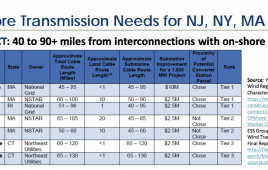In a groundbreaking analysis, a recent report reveals that forthcoming offshore wind proposals in the United States will necessitate an extensive network of offshore transmission spanning up to 3,000 miles. This study marks a significant milestone in the development of renewable energy infrastructure and highlights the immense scale of future projects.
The Enormous Scope of Offshore Wind Ventures
This comprehensive investigation sheds light on the colossal magnitude of upcoming offshore wind ventures across American coastlines. With ambitious plans to harness clean and sustainable energy from vast expanses of open water, these projects are poised to revolutionize the nation’s power generation landscape.
However, this transformative endeavor comes with its own set of challenges. The report emphasizes that connecting these sprawling offshore wind farms to onshore grids requires an intricate web of underwater cables and substations capable of transmitting electricity over distances exceeding 3,000 miles.
To put this into perspective, such an expansive transmission network would be equivalent to stretching from New York City all the way to Los Angeles or crossing multiple international borders within Europe. The sheer scale is awe-inspiring and underscores both the complexity and potential benefits associated with embracing offshore wind as a viable source for meeting America’s growing energy demands.
Pioneering Renewable Energy Infrastructure
This pioneering study serves as a clarion call for policymakers, investors, and industry leaders alike. It highlights not only the need for substantial financial investments but also strategic planning and collaboration among various stakeholders involved in developing this cutting-edge renewable energy infrastructure.
Moreover, building such extensive transmission networks presents technical hurdles that demand innovative solutions. Engineers must design robust subsea cables capable of efficiently transmitting large volumes of electricity while minimizing losses over long distances—an engineering feat requiring meticulous attention to detail and advanced materials.
Furthermore, the report underscores the importance of establishing a regulatory framework that supports the rapid deployment of offshore wind projects. Streamlined permitting processes, clear guidelines for environmental impact assessments, and collaboration between federal agencies are crucial in expediting project timelines while ensuring sustainable development.
A Bright Future on the Horizon
In conclusion, this groundbreaking report illuminates the immense potential of offshore wind energy in reshaping America’s power generation landscape. While acknowledging the formidable challenges ahead, it also highlights an unprecedented opportunity to embrace clean and renewable sources at an unprecedented scale.
By investing in extensive offshore transmission infrastructure spanning up to 3,000 miles, we can unlock vast reserves of green energy and pave the way towards a more sustainable future. The time has come for policymakers and industry leaders to seize this momentous occasion and propel our nation into a new era powered by wind.


